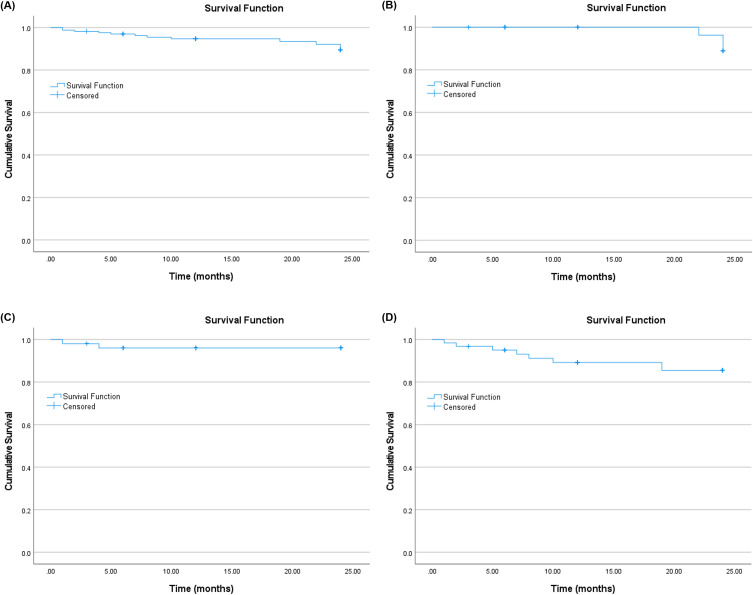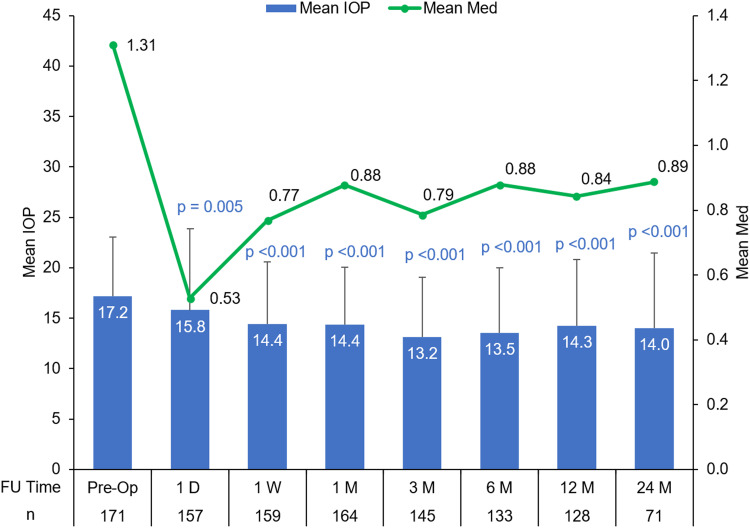Real-World Outcomes of Canaloplasty and Trabeculotomy Combined with Cataract Surgery in Eyes with All Stages of Open-Angle Glaucoma.
IF 1.8
Q3 OPHTHALMOLOGY
引用次数: 0
Abstract
Purpose To evaluate the long-term safety and efficacy of sequential canaloplasty and trabeculotomy combined with cataract surgery in patients with mild, moderate, and advanced open-angle glaucoma. Patients and Methods Case records of 171 consecutive patients (171 eyes) who had undergone cataract surgery followed by canaloplasty (≥180°) and trabeculotomy (≥90°) for mild, moderate, or advanced open-angle glaucoma (Shaffer grade ≥3) using the OMNI Surgical System (Sight Sciences, Inc., Menlo Park, CA) were analyzed retrospectively. Efficacy endpoints included change in mean IOP and number of medications from baseline to postoperative 12- and 24-months for the overall dataset and stratified by each stage of glaucoma. Kaplan–Meier survival analysis of success (eyes that did not require secondary surgical interventions (SSI)) by postoperative 24 months was also performed. Results Postoperatively, there was a statistically significant reduction in IOP (baseline of 17.2 mmHg on 1.3 medicines reduced to 14.3 on 0.8 medicines (12 months) and 14.0 on 0.9 medicines (24 months), p<0.001 for both time points). Eyes with advanced glaucoma (N=63) maintained significant IOP reduction (17.8 mmHg on 1.6 medicines at baseline reduced to 13.6 mmHg on 1.3 medicines (12 months) and 13.0 on 1.5 medicines (24 months), p<0.001). Kaplan–Meier analysis showed a 93.0% survival probability for the avoidance of SSI at 2 years after surgery. Conclusion Canaloplasty and trabeculotomy combined with cataract surgery provided effective IOP reduction for eyes with all stages of glaucoma at postoperative 12 and 24 months, and the procedure yielded a 93% survival rate for SSI avoidance at 2 years.



小梁切开术联合白内障手术治疗各阶段开角型青光眼的实际疗效。
目的:评价轻、中、晚期开角型青光眼患者行序贯小管成形术、小梁切开术联合白内障手术的长期安全性和有效性。患者和方法:回顾性分析使用OMNI手术系统(Sight Sciences, Inc., Menlo Park, CA)治疗轻度、中度或晚期开角型青光眼(Shaffer分级≥3级)的171例连续患者(171只眼)的病例记录,这些患者接受了白内障手术,随后进行了小管成形术(≥180°)和小叶切开术(≥90°)。疗效终点包括整个数据集从基线到术后12个月和24个月的平均IOP变化和药物数量,并按青光眼的每个阶段分层。还进行了术后24个月成功(不需要二次手术干预(SSI)的眼睛)的Kaplan-Meier生存分析。结果:术后,IOP的降低具有统计学意义(基线值为17.2 mmHg,使用1.3种药物后降低到14.3 mmHg,使用0.8种药物后降低到12个月,使用0.9种药物后降低到14.0 mmHg,使用24个月)。结论:在术后12个月和24个月,所有阶段青光眼患者的IOP都得到了有效的降低,该手术在2年避免SSI的生存率为93%。
本文章由计算机程序翻译,如有差异,请以英文原文为准。
求助全文
约1分钟内获得全文
求助全文

 求助内容:
求助内容: 应助结果提醒方式:
应助结果提醒方式:


